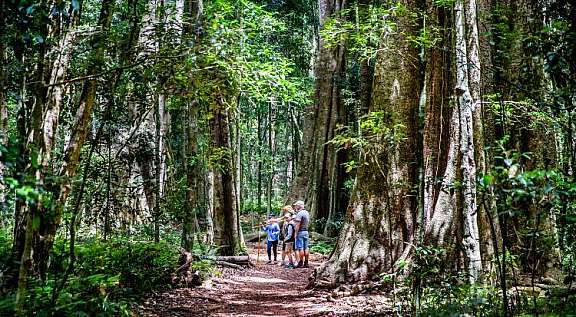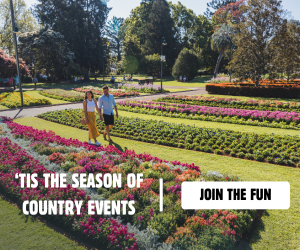
Explore Central Queensland Highland's Iconic National Parks
Unearth five national parks across five days throughout Central Queensland Highlands. Pack a swag, load up the 4WD and head inland to discover these lush natural landscapes.
There’s magic in the mountains, but there’s serious magic in the Bunya Mountains – the 11,700-hectare expanse of green space that plays home to one of Queensland’s most underrated national parks.
This spectacular wilderness sits atop the Great Dividing Range, approximately 1100m above sea level, rising out of the farming plains of the Western Downs and South Burnett who sit quietly in its foothills.
The Bunya Mountains area has been drawing visitors for centuries, with recorded tales of Aboriginal communities coming together to celebrate the harvest of the Bunya Nuts.
Today, the mountains have a similar effect, luring visitors from all over the world to its flora and fauna – whether it be for the red-necked wallabies who graze the rolling hills or crimson rosellas who land straight into your hand.
To help you discover the Bunya Mountains, here’s everything you need to know before you go:

Bunya Mountains, Western Downs
The Bunya Mountains straddles two Southern Queensland Country regions – the Western Downs and the South Burnett. You’ve got options if coming from Brisbane, choosing to drive from the south through Dalby or north via the Sunshine Coast. Either way, it’s about a three-hour drive from Brisbane (125km coming from Toowoomba), which swiftly turns from highway cruising to steep, mountain winding roads.
No matter which way you come, we’d recommend mixing up your return journey to see the Bunya Mountains from the flip side.

It would be fair to say that for every metre of altitude you climb, your shoulder’s and stress levels drop accordingly. The Bunya Mountains aren’t just a nature refuge, but a refuge for tired city-workers wanting to connect with nature, listen to the birds and take in sunset with spectacular views. This national park feels like a world away from anywhere and it helps that with limited phone reception, you might as well be world’s away from your normal work obligations.

The foliage of the Bunya Mountains is famous, with its very own Bunya Pine collection, which makes up the largest stand of these pines in the world. It’s not all pine trees rising through the forest floor – there’s plenty of variety from rainforest, nine different types to be precise, which range through to eucalyptus forests depending on the altitude. The Bunya pine is undoubtably what draws most people to these parts with their thick trunks which wear over 600 rings and rise 25 metres high.
Keep your eyes on the forest floor for their Bunya Nuts, split open by both their fall from great heights and the forest floor critters who consider them a delicacy of this forest.
On the fauna front, the first face you’re likely to see if the crimson lorikeets who pepper the thick green foliage with their glossy red feathers.
The birdlife goes beyond these colourful chirpers, there are more than 210 different bird species in the Bunyas, so it’s worth packing your bird book to tick them all off.

When you’re staying in a national park famous for forest, you’ll want to pack your walking shoes to get amongst them. The Bunya Mountains have both National Park grade 3 and 4 walks, with varying lengths to suit travellers on even the tightest of time frames. For a starter-track, there’s the Bunya Bunya track, which is 500m return and for the more adventurous, try the 12km return Cherry Plain to Burtons Well for a more strenuous stroll.
When you’re not bushwalking, you’ll join the other visitors soaking up the serenity, whether it be from the flat grassy areas or lookouts that afford this area panoramic views over the South Burnett and Western Downs.
There’s no shortage of picnic areas to throw down a rug, whether it’s at Dandabah, Westcott or Cherry Plain – and don’t worry you don’t have to DIY the picnic – there’s two cafes to do the meal-prep should you be so inclined.

Choose your own accommodation adventure in the Bunya Mountains, with the choice of camping, caravanning (although note, you’ll need to consider whether your van is suitable for the windy tracks to the top), motels, holiday homes and cabins. If DIY accommodation is your style, you can sleep within the national park at Dandabah, Westcott and Burtons Well, by picking up a camping permit through Queensland Parks. For something more comfortable, the Bunya Mountains Accommodation Centre offers 104 different holiday homes across the mountain top, to base your Bunya Mountains adventure.

A national park is probably the last place you’d expect to find a whisky bar, but you’ll find over 116 varieties at Shackleton’s Whisky Bar, which wears the title of Australia’s highest whisky bar. Shackleton’s and its neighbouring restaurant, The Bunyas, is reason enough to make a night or two out of your Bunya Mountains stay. Choose your drop, or better yet, let the staff make a selection for you to enjoy a neat nip in front of the fire or outside under a blanket of stars.

Pack your woollies! Being so high, the Bunya Mountains are always degrees cooler than its surrounding parts. A jumper is a packing must, even in summer – just in case the temperatures plummet. The Bunya Mountains enjoy four seasons, which makes it well worth coming back to see it in a contrasting season because the colours of the forest are almost unrecognisable.
Regardless of whatever season you choose to visit, don’t forget to look up. The stars in this part of Big Sky Country are proof this area is truly magical.


Subscribe now to receive a free downloadable Country Drive Bingo template, and let us share our specially curated holiday tips, news and deals.


Southern Queensland Country Tourism acknowledges the Traditional Custodians of the lands and waterways that run through these regions. We pay our respects to Aboriginal and Torres Strait Islander Elders past, present and emerging.
Subscribe now to receive a free downloadable Country Drive Bingo template, and let us share our specially curated holiday tips, news and deals.